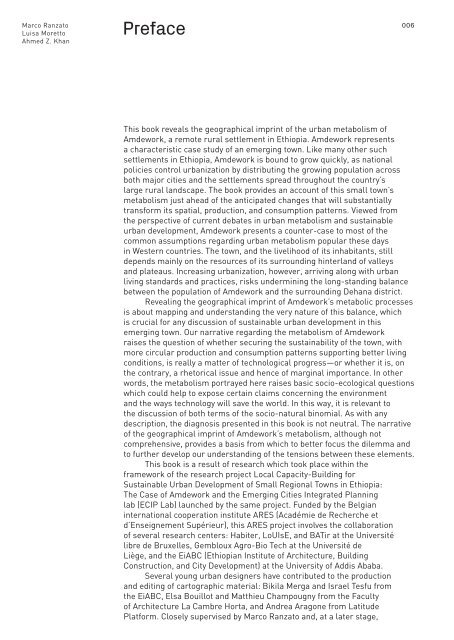Metabolism of an Emerging Town in Ethiopia – The Case of Amdework
ISBN 978-3-86859-531-4 https://www.jovis.de/de/buecher/product/metabolism-of-an-emerging-town.html
ISBN 978-3-86859-531-4
https://www.jovis.de/de/buecher/product/metabolism-of-an-emerging-town.html
Create successful ePaper yourself
Turn your PDF publications into a flip-book with our unique Google optimized e-Paper software.
Marco R<strong>an</strong>zato<br />
Luisa Moretto<br />
Ahmed Z. Kh<strong>an</strong><br />
Preface<br />
006<br />
This book reveals the geographical impr<strong>in</strong>t <strong>of</strong> the urb<strong>an</strong> metabolism <strong>of</strong><br />
<strong>Amdework</strong>, a remote rural settlement <strong>in</strong> <strong>Ethiopia</strong>. <strong>Amdework</strong> represents<br />
a characteristic case study <strong>of</strong> <strong>an</strong> emerg<strong>in</strong>g town. Like m<strong>an</strong>y other such<br />
settlements <strong>in</strong> <strong>Ethiopia</strong>, <strong>Amdework</strong> is bound to grow quickly, as national<br />
policies control urb<strong>an</strong>ization by distribut<strong>in</strong>g the grow<strong>in</strong>g population across<br />
both major cities <strong>an</strong>d the settlements spread throughout the country’s<br />
large rural l<strong>an</strong>dscape. <strong>The</strong> book provides <strong>an</strong> account <strong>of</strong> this small town’s<br />
metabolism just ahead <strong>of</strong> the <strong>an</strong>ticipated ch<strong>an</strong>ges that will subst<strong>an</strong>tially<br />
tr<strong>an</strong>sform its spatial, production, <strong>an</strong>d consumption patterns. Viewed from<br />
the perspective <strong>of</strong> current debates <strong>in</strong> urb<strong>an</strong> metabolism <strong>an</strong>d susta<strong>in</strong>able<br />
urb<strong>an</strong> development, <strong>Amdework</strong> presents a counter-case to most <strong>of</strong> the<br />
common assumptions regard<strong>in</strong>g urb<strong>an</strong> metabolism popular these days<br />
<strong>in</strong> Western countries. <strong>The</strong> town, <strong>an</strong>d the livelihood <strong>of</strong> its <strong>in</strong>habit<strong>an</strong>ts, still<br />
depends ma<strong>in</strong>ly on the resources <strong>of</strong> its surround<strong>in</strong>g h<strong>in</strong>terl<strong>an</strong>d <strong>of</strong> valleys<br />
<strong>an</strong>d plateaus. Increas<strong>in</strong>g urb<strong>an</strong>ization, however, arriv<strong>in</strong>g along with urb<strong>an</strong><br />
liv<strong>in</strong>g st<strong>an</strong>dards <strong>an</strong>d practices, risks underm<strong>in</strong><strong>in</strong>g the long-st<strong>an</strong>d<strong>in</strong>g bal<strong>an</strong>ce<br />
between the population <strong>of</strong> <strong>Amdework</strong> <strong>an</strong>d the surround<strong>in</strong>g Deh<strong>an</strong>a district.<br />
Reveal<strong>in</strong>g the geographical impr<strong>in</strong>t <strong>of</strong> <strong>Amdework</strong>’s metabolic processes<br />
is about mapp<strong>in</strong>g <strong>an</strong>d underst<strong>an</strong>d<strong>in</strong>g the very nature <strong>of</strong> this bal<strong>an</strong>ce, which<br />
is crucial for <strong>an</strong>y discussion <strong>of</strong> susta<strong>in</strong>able urb<strong>an</strong> development <strong>in</strong> this<br />
emerg<strong>in</strong>g town. Our narrative regard<strong>in</strong>g the metabolism <strong>of</strong> <strong>Amdework</strong><br />
raises the question <strong>of</strong> whether secur<strong>in</strong>g the susta<strong>in</strong>ability <strong>of</strong> the town, with<br />
more circular production <strong>an</strong>d consumption patterns support<strong>in</strong>g better liv<strong>in</strong>g<br />
conditions, is really a matter <strong>of</strong> technological progress—or whether it is, on<br />
the contrary, a rhetorical issue <strong>an</strong>d hence <strong>of</strong> marg<strong>in</strong>al import<strong>an</strong>ce. In other<br />
words, the metabolism portrayed here raises basic socio-ecological questions<br />
which could help to expose certa<strong>in</strong> claims concern<strong>in</strong>g the environment<br />
<strong>an</strong>d the ways technology will save the world. In this way, it is relev<strong>an</strong>t to<br />
the discussion <strong>of</strong> both terms <strong>of</strong> the socio-natural b<strong>in</strong>omial. As with <strong>an</strong>y<br />
description, the diagnosis presented <strong>in</strong> this book is not neutral. <strong>The</strong> narrative<br />
<strong>of</strong> the geographical impr<strong>in</strong>t <strong>of</strong> <strong>Amdework</strong>’s metabolism, although not<br />
comprehensive, provides a basis from which to better focus the dilemma <strong>an</strong>d<br />
to further develop our underst<strong>an</strong>d<strong>in</strong>g <strong>of</strong> the tensions between these elements.<br />
This book is a result <strong>of</strong> research which took place with<strong>in</strong> the<br />
framework <strong>of</strong> the research project Local Capacity-Build<strong>in</strong>g for<br />
Susta<strong>in</strong>able Urb<strong>an</strong> Development <strong>of</strong> Small Regional <strong>Town</strong>s <strong>in</strong> <strong>Ethiopia</strong>:<br />
<strong>The</strong> <strong>Case</strong> <strong>of</strong> <strong>Amdework</strong> <strong>an</strong>d the <strong>Emerg<strong>in</strong>g</strong> Cities Integrated Pl<strong>an</strong>n<strong>in</strong>g<br />
lab (ECIP Lab) launched by the same project. Funded by the Belgi<strong>an</strong><br />
<strong>in</strong>ternational cooperation <strong>in</strong>stitute ARES (Académie de Recherche et<br />
d’Enseignement Supérieur), this ARES project <strong>in</strong>volves the collaboration<br />
<strong>of</strong> several research centers: Habiter, LoUIsE, <strong>an</strong>d BATir at the Université<br />
libre de Bruxelles, Gembloux Agro-Bio Tech at the Université de<br />
Liège, <strong>an</strong>d the EiABC (Ethiopi<strong>an</strong> Institute <strong>of</strong> Architecture, Build<strong>in</strong>g<br />
Construction, <strong>an</strong>d City Development) at the University <strong>of</strong> Addis Ababa.<br />
Several young urb<strong>an</strong> designers have contributed to the production<br />
<strong>an</strong>d edit<strong>in</strong>g <strong>of</strong> cartographic material: Bikila Merga <strong>an</strong>d Israel Tesfu from<br />
the EiABC, Elsa Bouillot <strong>an</strong>d Matthieu Champougny from the Faculty<br />
<strong>of</strong> Architecture La Cambre Horta, <strong>an</strong>d Andrea Aragone from Latitude<br />
Platform. Closely supervised by Marco R<strong>an</strong>zato <strong>an</strong>d, at a later stage,


















